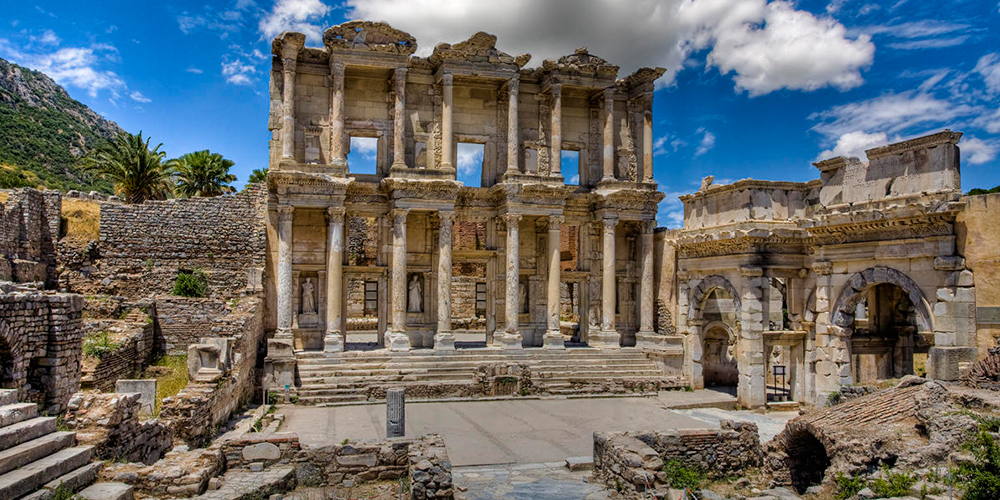 Turkey N37 55 45 E27 21 34
Turkey N37 55 45 E27 21 34
Date of Inscription: 2015
Criteria: (iii)(iv)(vi)
Property : 663 ha
Buffer zone: 1,246 ha
Ref: 1018rev
Located within what was once the estuary of the River Kaystros, Ephesus comprises successive Hellenistic and Roman settlements founded on new locations, which followed the coastline as it retreated westward. Excavations have revealed grand monuments of the Roman Imperial period including the Library of Celsus and the Great Theatre. Little remains of the famous Temple of Artemis, one of the “Seven Wonders of the World,” which drew pilgrims from all around the Mediterranean. Since the 5th century, the House of the Virgin Mary, a domed cruciform chapel seven kilometres from Ephesus, became a major place of Christian pilgrimage. The Ancient City of Ephesus is an outstanding example of a Roman port city, with sea channel and harbour basin.
Outstanding Universal Value
Brief synthesis
Within what was once the estuary of the river Kaystros, a continuous and complex settlement history can be traced in Ephesus beginning from the seventh millennium BCE at Cukurici Mound until the present at Selçuk. Favourably located geographically, it was subject to continuous shifting of the shore line from east to west due to sedimentation, which led to several relocations of the city site and its harbours. The Neolithic settlement of Cukurici Mound marking the southern edge of the former estuary is now well inland, and was abandoned prior to settlement on the Ayasuluk Hill from the Middle Bronze Age. Founded by the 2nd millennium BCE, the sanctuary of the Ephesian Artemis, originally an Anatolian mother goddess, became one of the largest and most powerful sanctuaries of the ancient world. The Ionian cities that grew up in the wake of the Ionian migrations joined in a confederacy under the leadership of Ephesus. In the fourth century BCE, Lysimachos, one of the twelve generals of Alexander the Great, founded the new city of Ephesus, while leaving the old city around the Artemision. When Asia Minor was incorporated into the Roman Empire in 133 BCE, Ephesus was designated as the capital of the new province Asia. Excavations and conservation over the past 150 years have revealed grand monuments of the Roman Imperial period lining the old processional way through the ancient city including the Library of Celsus and terrace houses. Little remains of the famous Temple of Artemis, one of the ‘seven wonders of the world’ which drew pilgrims from all around the Mediterranean until it was eclipsed by Christian pilgrimage to the Church of Mary and the Basilica of St. John in the 5th century CE. Pilgrimage to Ephesus outlasted the city and continues today. The Mosque of Isa Bey and the medieval settlement on Ayasuluk Hill mark the advent of the Selçuk and Ottoman Turks.
Criterion (iii): Ephesus is an exceptional testimony to the cultural traditions of the Hellenistic, Roman Imperial and early Christian periods as reflected in the monuments in the centre of the Ancient City and Ayasuluk. The cultural traditions of the Roman Imperial period are reflected in the outstanding representative buildings of the city centre including the Celsus Library, Hadrian’s Temple, the Serapeion and Terrace House 2, with its wall paintings, mosaics and marble panelling showing the style of living of the upper levels of society at that time.
Criterion (iv): Ephesus as a whole is an outstanding example of a settlement landscape determined by environmental factors over time. The ancient city stands out as a Roman harbour city, with sea channel and harbour basin along the Kaystros River. Earlier and subsequent harbours demonstrate the changing river landscape from the Classical Greek to Medieval periods.
Criterion (vi): Historical accounts and archaeological remains of significant traditional and religious Anatolian cultures beginning with the cult of Cybele/Meter until the modern revival of Christianity are visible and traceable in Ephesus, which played a decisive role in the spread of Christian faith throughout the Roman Empire. The extensive remains of the Basilica of St. John on Ayasuluk Hill and those of the Church of Mary in Ephesus are testament of the city’s importance to Christianity. Two important Councils of the early Church were held at Ephesus in 431 and 449 CE, initiating the veneration of Mary in Christianity, which can be seen as a reflection of the earlier veneration of Artemis and the Anatolian Cybele. Ephesus was also the leading political and intellectual centre, with the second school of philosophy in the Aegean, and Ephesus as a cultural and intellectual centre had great influence on philosophy and medicine.
Integrity
The serial components contain sites which demonstrate the long settlement history of the place, each making a significant contribution to the overall Outstanding Universal Value. Together the components include all elements necessary to express Outstanding Universal Value and the property is of adequate size to ensure the complete representation of the features and processes which convey the property’s significance.
Authenticity
The component properties retain authenticity in terms of location and setting, form and design. The remains at Cukurici Mound retain authenticity in terms of materials and substance. The other two component properties have all been subject to stone robbing in the past and subsequently to varying degrees of anastylosis, reconstruction and stabilisation using modern materials. Recent interventions have rectified damage caused by earlier inappropriate materials where possible and now make use of reversible techniques.
Source: Unesco.org

